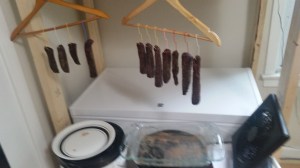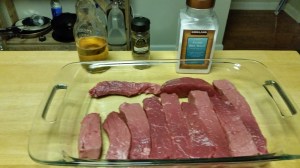It’s long overdue, but I’m going to tell you about Biltong, which is a thicker, South African version of beef jerky. The primary differences between biltong and traditional jerky is that biltong is made from thicker slices of meat and cured slower, without heat. It is one more tool in the arsenal of preparedness; it’s another way to prepare food for long term storage that doesn’t require electricity, and is a skill that can make a premium product that you might otherwise eat normally, saving you lots of money over your lifetime.
The basic ingredients are:
lean meat, sliced THICKLY (preferably beef if you are just starting, but any meat should work)
vinegar (preferably apple cider or balsamic)
salt COARSE (preferably sea salt, or kosher, not iodized table salt)
pepper
coriander
brown sugar (optional)
Start by slicing your meat into strips, approximately 1 inch thick and marinading them in the vinegar for about an hour or more. Then sprinkle them with salt to evenly coat all sides of the meat. Sprinkle with pepper, coriander, and sugar (I did not do) for flavor.
After the meat has been properly coated, you can either let sit in the fridge over night, or hang immediately. I waited overnight. Hang the meat on any sort of hook you can find, the easiest method is to unbend some paper clips. Hang them somewhere cool and dry, out of direct sunlight. If you are worried about pest or flying insects, you can either hang them in a cheesecloth/breathable bag, or have a fan blowing on them so flies can’t land on it. The fan has the added benefit of drying the meat out faster. I hung mine on paper clips with clothes hangers over drip trays, with a fan blowing on them in a shaded corner of the pantry.
After about 4-5 days, I could noticeably see the difference. The outside was darker and hard, but the inside was still slightly raw and squishy. If you typically like your meat medium-medium rare, you will like it this way, the biltong is very tender and chewy with a great taste. I cut off a few slivers to taste, but let the majority of it go until 7-8 days, at which point it was completely dried out. It had the same pleasant taste, not salty like traditional jerky, but was much tougher at this point, and will last a long time in a jar in the pantry (not needing any refrigeration).
I should note that it is very important to select lean cuts of meat, or trim your meat well, as any fat will become chewy strands within the biltong, that might get stuck in your teeth. I also found the completely cured biltong much easier to eat when cut into smaller pieces compared to chewing on a whole stick, the thicker slices were tough to chew at times.
Overall, I consider this a great success, and will continue to experiment and refine my recipe.



Tasted great too!
LikeLike